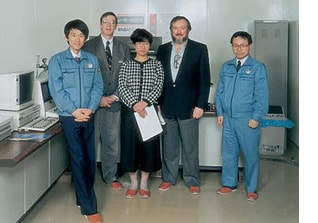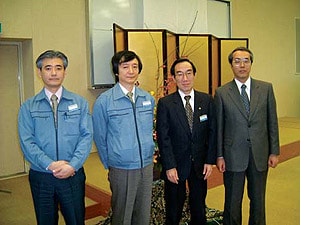
Dr. Cotter's Certainty Opened the Door of Tanaka to the World
| Robert J. Cotter (Ph.D.)* Professor of Pharmacology and Molecular Sciences Professor of Biophysics and Biophysical Chemistry Director: Middle Atlantic Mass Spectrometry Laboratory Johns Hopkins University, School of Medicine |
Catherine Fenselau (Ph.D.) * Professor of Chemistry and Biochemistry University of Maryland, College of Life Science |
* Dr. Cotter and Dr. Fenselau are partners each other in research as well as in private life.
As you know, Catherine and I have always felt that Koichi Tanaka played a very critical role in the development of the ionization techniques that now permit analysis of very large biological molecules. At a time when particle beam, electrospray and laser methods were being utilized for peptides and small proteins, Koichi was first able to cross the barrier to large proteins. As such, I believe that he provided considerable inspiration to the rest of the mass spectrometry community to look at even higher masses. Koichi is most deserving of the Nobel Prize for this effort, and we are very pleased to share this moment with him in Sweden.
 |
Tanaka and others in front of the first LAMS-50K at Shimadzu Japan in 1989 From left, Koichi Tanaka (Shimadzu Corp.), Dr. Cotter(Johns Hopkins Univ.), Dr. Hotta (Kobe Women's Univ.), Dr. A. Burlingame (Univ. of California), Katsuaki Shiratsuchi (Shimadzu Corp.) |
Recollections of the Other Four of the Research Quintet
Tamio Yoshida (Ph.D.)
General Manager, Technology Research Laboratory
Shimadzu Corporation
Research commenced in 1982. We decided the field of R&D that each one of us would take as his responsibility. We met once a week to discuss progress status and problems, with each making a monthly report, so that the project could move forward with each member kept fully informed about what the others were doing. This was extremely effective in grasping the extent of research progress and marshalling everyone's priorities. By mid-project we had already obtained world-beating data, but we made it our research strategy to keep the data in house until we had compiled all results. We each took responsibility for a certain section of the results and gave five presentations and provided two publications about our work at the Conference of the Mass Spectrometry Society of Japan in 1987. The work concerned with the Nobel Prize is "matrix assisted laser desorption/ionization", which largely breaks down into four basic requirement technologies: "ion generation", "ion separation", "ion detection" and "data processing". It was because we handled development work for these four requirements for biological macromolecules in a steadfast manner that we reached our goal in a comparatively short time and it has become the monumental event in the field of mass spectrometry. From then on, in each area of work, development of the matrix and a time-of- flight mass spectrometer progressed as a solid link to the successful MALDI-TOF of today. I personally believe that Koichi Tanaka's Nobel Prize is not just for the development of the biological macromolecule ionization method but also for the effort he put into disseminating the method over the many ensuing years. Moreover, there were no shortcuts in the development work; Koichi Tanaka's major breakthrough derived from meticulous attention to detail in building up time-consuming results. I also think this has a strong connection to this magnificent but unexpected award.
 |
The four members who worked on the project with Koichi Tanaka from left, Yutaka Ido (Manager in the Device Department), Satoshi Akita (R&D Manager of the Device Department). Tamio Yoshida (General Manager of the Technology Research Laboratory) and Yoshikazu Yoshida (Senior Manager of the Technology Research Laboratory) |


